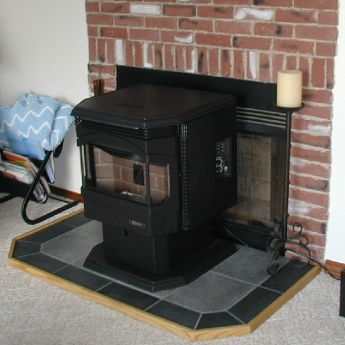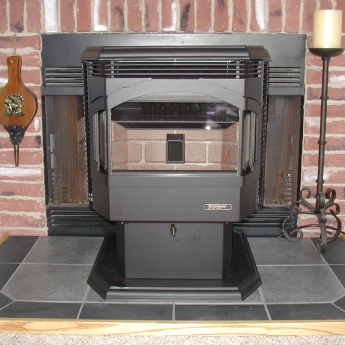Wood Pellet Stoves
Green Heat - good for the environment and your wallet
With the costs of energy going up at what sometimes seems like exponential rates many PRV members are looking for ways to reduce on their energy bills. This is especially true during the cold winter heating months.
Since most PRV members heat their townhouses with electric heat they bear the burden of the high electric costs in Massachusetts. According to official energy statistics published by the Energy Information Administration, Massachusetts has the fourth highest average residential electric rates.
One way to mitigate the costs of heating your townhome may be through the installation of a wood pellet stove or wood pellet fireplace insert. Wood pellet stoves burn pellets of wood formed by compressing sawdust under great pressure. They look something like rabbit food pellets. The pellets are cylinders roughly 1/4 inch in diameter by about 3/4 inch long. The sawdust the pellets are made from is usually the waste product of some other woodworking process such as the creation of furniture or wood flooring. Wood pellets generally come packaged in 40 lb. plastic bags with 50 bags on a pallet making up one ton of pellets.
Wood pellet heat can be thought of as nearly carbon neutral since the CO2 released during the burning of the pellets is no greater than if the sawdust had decomposed naturally. There is only a small amount of additional CO2 generated from the manufacture and shipping of the pellets.
The burning of the wood pellets in a good pellet stove is generally about 80-85% efficient. This compares well with more common oil furnace or gas boiler heating methods.
Wood pellet stoves come in two general types: freestanding and inserts. The insert type is made to fit within the firebox of an existing fireplace. The freestanding are complete stoves that are made to to be used outside of a firebox though they still need to be placed on a noncombustible hearth. The function of the freestanding or insert will be similar, but the freestanding stoves usually have a larger hopper capacity as well as a larger ash receptacle. This can mean fewer trips to the stove to add pellets or remove ashes.
The inner mechanics of wood pellet stoves are fairly simple. The stove has a hopper which holds the wood pellets. Then there is an auger which transports pellets from the hopper and drops them into the fire pot. It is inside the fire pot where the action happens. The pellets burn while being force fed air from a blower motor to accelerate combustion and create a very hot flame. The hot air from this combustion heats a series of heat exchanger tubes through which a second blower motor pushes air. This air, after passing through the heat exchangers, is blown out the front of the stove and into your living area.
All pellet stoves use electricity to power the auger and the blower motors. If you lose power your stove will not run unless you have installed a battery backup system. You can obtain these from the supplier of your stove.
You’ll find that some stoves differ slightly in design as they don’t use a fire pot, but instead have a burn shelf. These stoves, such as those made by Harman, have an auger that pushes the pellets up onto a burn shelf instead of dropping them into a fire pot. The leading edge of the pellet pile on the shelf burns and as new pellets are pushed onto the shelf by the auger it pushes the remaining ash off the shelf. You’ll find fierce defenders of both the top auger (fire pot) and bottom auger (burn shelf) technologies. Do some reading and decide for yourself which is best before you buy.
You’ll discover that in addition to a battery backup there are other nice features you may want to have with your stove. Some stoves are capable of self ignition which means that they can start a fire in the fire pot without the use of any fire starting materials. This is convenient, especially when coupled with a thermostat control. When the temperature in the room drops the thermostat starts up the stove. Auto-ignition and thermostat control are must have features in my opinion.
I have used a wood pellet stove here at PRV since 2003. Mine is a Lopi Pioneer model which is a free standing stove. It sits in front of my fireplace atop a custom hearth that simply lays on the existing carpet. The exhaust gases are vented through 4 inch diameter flex-piping running up through the existing fireplace chimney. I also have a custom cut piece of painted sheet steel which closes the opening of the fireplace behind the stove to help reduce heat loss up the chimney and improve the appearance of the installation. See the pictures which were taken shortly following installation, before the sheet steel enclosure was added to the fireplace.
So, you may be asking yourself how much much is a wood pellet stove and how much can I expect to save on heating costs? I think it best to speak from my own experience here. When I purchased my stove in 2003 it was $2170. The custom hearth the stove sits on was $400. Delivery, parts and labor was an additional $1065. Remember, these were 2003 prices and the demand for wood pellet stoves has since increased so expect to pay more than I did back in 2003.
OK, now that you’ve had the sticker shock here are the savings. One ton of premium wood pellets retails for about $220-280 during the summer months. The secret is to buy what you need during the spring / summer and save as the prices only tend to go up during the winter months.
I use about two tons of pellets each year in order to maintain about a 68-70 ˚F temperature on the two living areas. Using a pellet price of $250/ton and about $40 additional for delivery I am spending about $540 to heat my townhouse for the entire winter. Contrast this to the 2300 kWhs of electricity I was using each month to heat my townhouse. At todays rates that would cost me roughly $390/month. Needless to say, I was not keeping my room temperatures anywhere near 68-70˚F when I was heating with electric; 60 - 62˚F was more like it. So, by using pellet heat my wife and I are warmer and spending less each month on heating costs.
Maintenance of a pellet stove is fairly simple. Each stove is different, but in general you’ll need to allow your stove to shutdown so you can clean the fire pot, heat exchangers and glass about twice each week. This takes about 15 minutes. Depending on the size of your ash pan expect to empty the ashes about 3 - 4 times each winter. It is amazing how little ash is left after the burning of one ton of pellets. An investment in an ash vacuum is suggested as a regular vacuum isn’t suited for vacuuming fine ash that may contain a hot ember lurking within. Play it safe and empty your ash into a noncombustible container with a cover. Annually, you’ll need to clean the blowers and the chimney pipe. Every couple of years you’ll want to replace the fireproof door gasket. Consult the stove’s owners manual for specific requirements.
Depending on the outside temperature and the temperature you like to maintain inside you’ll go through about 2 bags of pellets/day. My stove has a large hopper and can hold an entire 40 lb. bag of pellets. I simply cut the top off the bag and dump them into the hopper. Other stoves, especially the inserts, have smaller hoppers so you may need to dump the bag of pellets into a bucket and then scoop the pellets from the bucket into the stove’s hopper. I’ve included a link to an ingenious pellet pail which not only will hold your bag of pellets, but will open the bag for you as you drop it into the pail.
I’d be more than happy to entertain any questions you may have about wood pellet stoves. You can reach me via: webmaster@paulreverevillage.com
Please contact the board if you are thinking of installing a wood pellet stove in your townhome. They will be able to provide you with information regarding town code requirements and other legal requirements like a fire marshal inspection following installation.
- Jeffrey Grinnell, Webmaster - PRV
Here is a summary of the links I've gathered with information about wood pellet stoves. if you have a link related to wood pellet stoves that you would like to see added email me at webmaster@paulreverevillage.com
Lopi Stoves
http://www.lopistoves.com
Quadrfire Stoves
http://www.quadrafire.com
Harman Stoves
http://www.harmanstoves.com
Higgins Energy- Barre
http://www.higginsenergy.com
Enchanted Fireside- Worcester
http://www.enchantedfireside.com
The Stove Place - Shrewsbury
no webpage - Rt20 Shrewsbury (508) 754-7091
Pellet Stoves Guide
http://www.pelletstovesguide.com
Pellet Stoves - Hometips
http://www.hometips.com/cs-protected/guides/pellet.html
Consumers Guide to Pellet Stoves
http://www.woodpelletstoves.net
Pellets Stove Reviews
http://www.pellet-stove-review.com
Pellet Stoves - wikipedia
http://en.wikipedia.org/wiki/Pellet_stove
Pellet Stoves - Treehugger
http://www.treehugger.com/files/2006/07/pellet_stoves_a.php
Pellet Stoves - Consumer Reports
http://www.consumerreports.org/cro/appliances/heating-cooling-and-air/wood-stoves/buyers-guide-to-pellet-and-wood-burning-stoves-1-07/overview/0701_pellet-stove.htm
Pellet Stoves - Hearth.com
http://hearth.com
Pellet Fuel - Pellet Fuels Institute
http://www.pelletheat.org/2/index/index.html
Pellet Pail
http://www.pelletpail.com
Pellet Fuel - Energex
http://www.energex.com
Pellet Fuel - New England
http://www.pelletheat.com
Pellet Fuel - Pellet Sales
http://www.pelletsales.com




Information |
Community |
